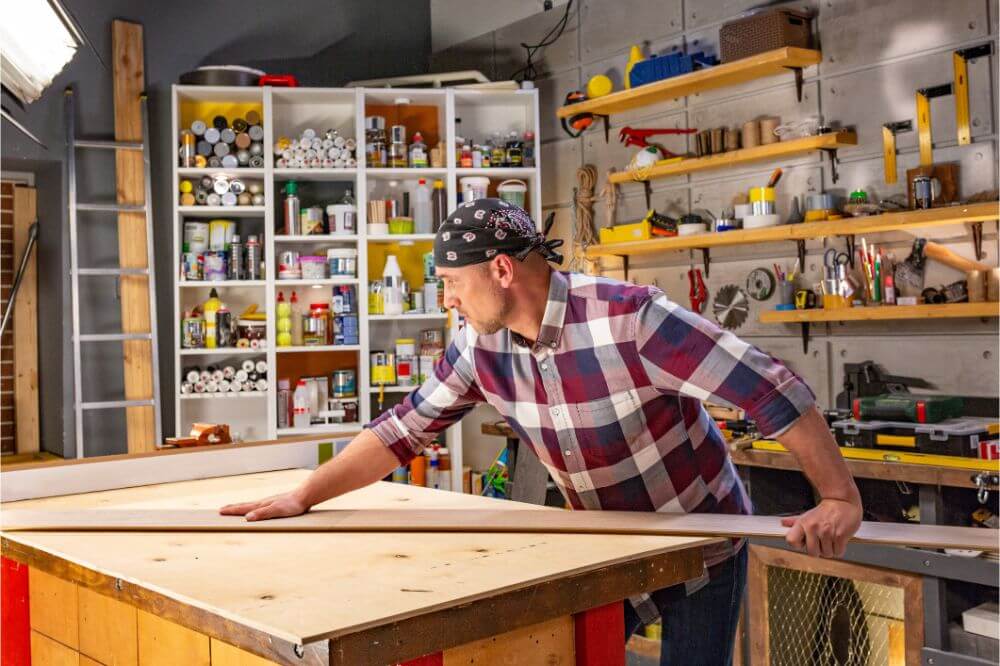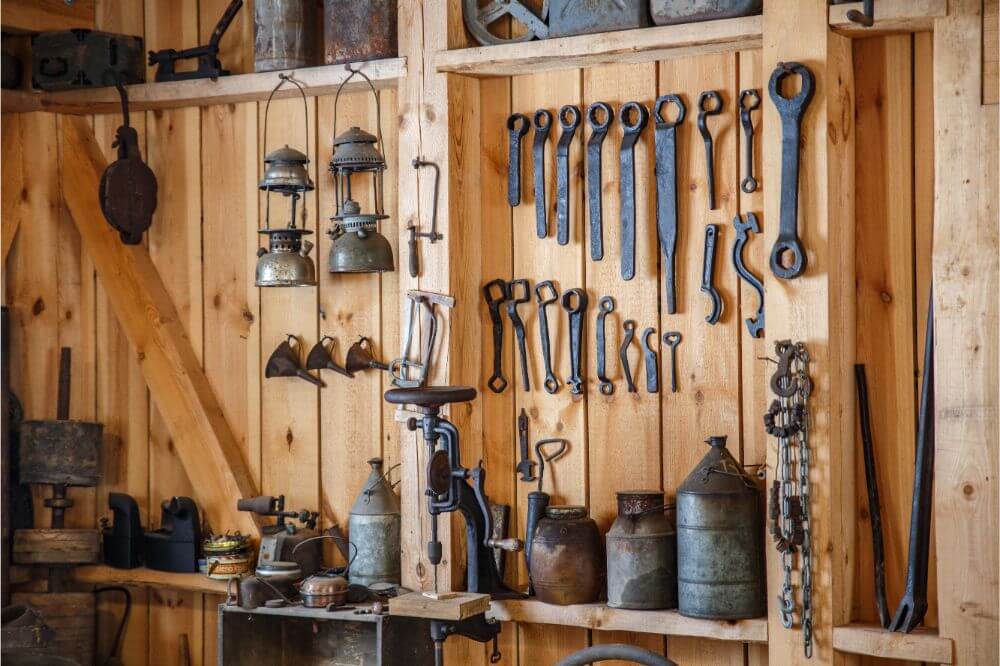
If woodworking is your profession or a hobby that you partake in very frequently, the option of building your own woodshop may already be one which you are actively considering. While it is a great idea, many woodworkers seem to hit the buffers when it comes to planning and building their woodworking shop.
Questions like what tools to include, how to lay it all out, and where to store everything you will need, are but three of the many issues that need to be overcome.
In this article, we are going to look at several aspects of building a woodworking shop and provide you with some ideas that have proven to work for other woodworking enthusiasts and professionals.
Contents
Planning Your Woodshop
Just as any woodworking project needs to be planned, your woodworking shop also needs to be planned. This applies not just drawing a layout but considering everything you will need to actually create your woodshop.
The list of things to consider includes the electrical supply, the water supply, the materials required to build the workshop (wood, fixtures, paint, etc.), what tools you are going to include, having proper access, ensuring there is sufficient light, calculating the budget required to make it all become a reality, and even finding the time for creating it too.
Size of the Workshop
This is an aspect of your woodshop that will most likely be determined by the building in which you plan to build it. Whether you have a garage, a shed, an outhouse, a basement, or a spare room in your house, they should all be able to accommodate it, albeit the size and number of tools you can set up in it will differ.
Obviously, the bigger the area you have, the more options you are going to have in terms of planning your workshop, but that does not mean small spaces should be ruled out, provided you plan your workshop correctly.
A great resource that will help you achieve that is 'The Ultimate Small Shop Guide' which has loads of tips and advice on setting up a workshop, including in spaces as small as 10 feet x 10 feet.
If you are lucky enough to have a large amount of space available, you might want to consider dividing your woodshop into two separate areas. One would be considered your main work area which will be where you do all your sawing and cutting.
The important point here is that this is where all the sawdust and shavings will be, so you'll want to ensure itis well ventilated and where possible has some kind of dust extraction system.
The second section of your woodshop would be the 'clean' area and it is here you will carry out tasks such as varnishing and applying other finishes to your projects. This clean area would also be ideal for storing your hand tools and other accessories.
Your Budget
The amount you are able or willing to spend on your woodshop will be a personal decision which you will no doubt make based on either your bank balance, your credit card limit or as will be the case for many, the blessing (or not) of your spouse or partner.
There is no hard and fast rule about how much you should or shouldn't spend, other than to advise you to get value for money when you are buying materials and tools, for example.
Whether you have a larger budget or are severely limited in what you can spend, always carry out due diligence on the companies you are buying from, especially with respect to pricier items like large tools.
List of Tools and Equipment
While you probably already have a list in mind of the tools you want in your woodshop, just in case you have missed one or two, below is a list of tools we suggest you include. With reference to the previous two paragraphs this might be subject to the size of the workshop you have, and the budget you have available.
- Workbench
- Radial arm saw
- Router and router table
- Bandsaw
- Circular saw
- Miter saw and chop saw
- Table saw and outfeed table
- Drill press
- Support stands
- Hand tools (e.g. cordless drill, sander)
- Bench tools (e.g. hammer, chisels)
- Storage racks

Extras to Consider
If your budget and space allow for them, these can be useful additional items for your woodworking shop.
- Vacuum cleaner
- Electric fan
- Portable air conditioning unit
- Portable heater
- Refrigerator (for cold drinks)
- Fire extinguisher
- First aid kit
Principles of Your Woodshop Layout
There will be many woodworkers reading this who have their own way of working, and that will include having certain tools placed in particular spots around them.
We are certainly not going to say you must stop this but will instead simply offer you some basic principles of how the layout of a woodshop can make the whole experience of working in it a better one. This is not going to be a case of 'put this there, put that there' but rather, they are suggestions relating to specific aspects of the layout.
Safety First
A woodworking shop that you set up should have a strong emphasis on your safety, and the safety of anyone else who might enter the woodshop.
One of the first things to consider is the positioning of power tools so that the power cords do not become trip hazards. You'll also want to think about the height and positioning of anything you mount on walls or hang from the ceilings so that there is no danger of you banging your head against them.
Thinking of your health means you may want to consider the ventilation of your woodshop so that dust and vapors can easily escape, rather than building up inside. Other safety items to consider are a fire extinguisher, and a first aid kit, and placing them somewhere which can be easily accessed.
The final point on safety applies if you have children and given the number of dangers in a woodshop, ensuring that those children cannot gain access to it. The woodshop should have a lockable door, and where possible any dangerous tools and materials should be stored in lockable cupboards when not in use.
In 'The Ultimate Small Shop Guide,' there is an entire section dedicated to ensuring your woodshop is safe. This includes a very useful safety checklist which allows you to confirm to yourself that you have done everything required to render your woodworking shop a safe place to work
Creating a Work Triangle
One of the best ideas for setting up your woodworking shop is based on something called the 'work triangle.' It is the same principle that kitchen designers use when designing kitchens where they include three workstations, namely the stove, the refrigerator, and the countertop.
The reason it is used is that it maximizes the amount of space available, which is critical when the space you have is limited.
If you apply this to your woodshop, you might have your main workbench as one side of the triangle, your hand tools storage area as the second, and your main fixed power tools such as a circular saw as the third. You obviously have scope to adapt this to take account of what tools you have.
Go With Workflow
Another basis for designing the layout of your woodshop is the workflow that you normally follow. Think of your woodshop in terms of being a production line and consider the sequence that any piece of wood will take from the minute it arrives, through to the last bit of finishing work that you might undertake on it.
Based on that, it makes sense to arrange your woodworking shop so that rather than moving that piece of wood across, back and all-around several times, it instead moves through in a logical path. This will make you more productive, and it is also a safer way to work too.
Make Everything Mobile
One idea which many woodworkers use to good effect is to make as many items in the woodshop mobile. This applies especially to larger tools and items which are normally very difficult to move and often require a second or third person to help you do so.
By utilizing mobile bases, castors, and trollies, you can make those large, heavy tools portable. This will enable you to move them to any part of your woodworking shop that they are needed. It also allows you to store them in the best way rather than simply leaving where they stand. Having wheeled trollies also helps you move larger pieces of lumber more easily too.
Let There Be Light
Every woodshop needs to be lit, and how you do this should be an important decision, especially when it comes to the layout of your workshop. If you have a window, then it makes sense to place your workbench on that wall to take advantage of all the light that it will receive through it. The added bonus is that you can look out at the view outside occasionally as you are working away at the bench.
If you do not have the advantage of natural light and are relying on electric lights, then you want to have the lights and your main workbench both positioned so that you have the most amount of light possible. If you are able to install multiple lights then do so, in order that as many areas of the workshop are lit brightly.
The biggest mistake people make is to have a light source behind them which means when you stand there, you are going to cast a shadow on to the item you are working on. Whether you have one, or several lights in the woodshop, position them so that they are in front of the workbench or fixed tool so that your shadow is on the floor behind you, and not the item in front of you.
Storage
The consideration of where you are going to store everything within your workshop is a significant one. You need to take into account the safe storage of everything, and also how conveniently you are storing them too.
The main item that you will be storing is your lumber and given that this can be very long and heavy it makes sense to have this stored near to the door of your woodshop. This means that when you buy lumber, you have the minimum distance to carry it once you get it to your woodshop.
Solvents, glues and other chemicals should obviously be kept in a lockable cupboard, and in such a way that there is little chance of you knocking anything over as you remove items for use.
Small hand tools, like hammers, chisels, and files should be stored close to your workbench. The other consideration in terms of storing tools is that some thought should be given to the order in which they are used. Common sense also plays a part in where you store items, with you having spares and accessories for specific tools stored close to them.
Also Utilize Outside Space
Many woodworkers take advantage of the fact that they have areas outside their main workshop. This will obviously depend on the location of your property and how close you are to neighboring properties.
However, if all that is compatible then jobs like painting or staining where there may be a lot of fumes are ideal jobs that you can take outside where there is the maximum amount of ventilation.
Make It Right For You
Despite all the ideas we have gone through, one thing you must remember is that this woodworking a shop is for you, and therefore it should be set up and laid out accordingly. This applies especially to your height and making sure that you have tools and workbenches set up so that they are neither too high nor too low for you.
A good rule of thumb, (or rule of waist), is to make have the height of everything as close to your waist level as possible. This is the height at which it should be the most convenient and comfortable for most people.

